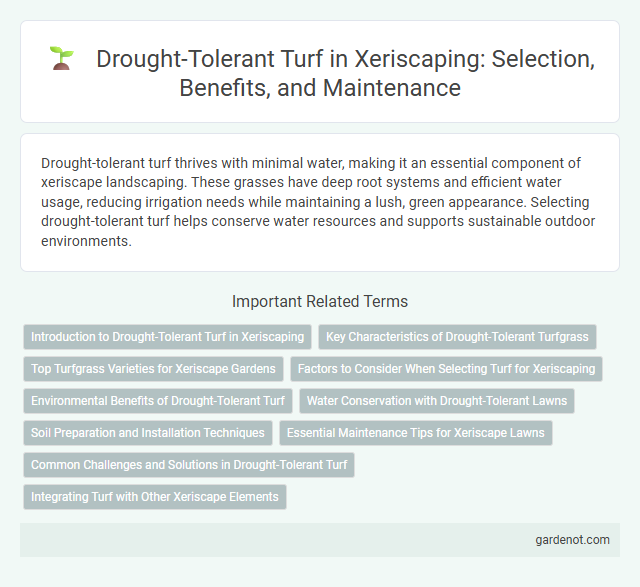Drought-tolerant turf thrives with minimal water, making it an essential component of xeriscape landscaping. These grasses have deep root systems and efficient water usage, reducing irrigation needs while maintaining a lush, green appearance. Selecting drought-tolerant turf helps conserve water resources and supports sustainable outdoor environments.
Introduction to Drought-Tolerant Turf in Xeriscaping
Drought-tolerant turf in xeriscaping utilizes grass species such as buffalo grass, Bermuda grass, and zoysia that require minimal water once established, significantly reducing irrigation needs. These grasses thrive in arid conditions by developing deep root systems that maximize moisture absorption and improve soil retention. Incorporating drought-tolerant turf in landscape design enhances water conservation while maintaining functional and aesthetically pleasing green spaces.
Key Characteristics of Drought-Tolerant Turfgrass
Drought-tolerant turfgrass features deep root systems that maximize water absorption and retention, reducing the need for frequent irrigation. These grasses exhibit slow growth rates and a dormancy phase, allowing them to survive extended dry periods without significant damage. Their adaptive leaf structures, such as narrow blades and waxy coatings, minimize water loss through transpiration, making them ideal for xeriscape landscapes.
Top Turfgrass Varieties for Xeriscape Gardens
Bermuda grass, buffalo grass, and zoysia grass rank among the top drought-tolerant turfgrass varieties ideal for xeriscape gardens due to their low water requirements and high heat tolerance. These turfgrasses thrive in arid climates, reducing irrigation needs by up to 50% compared to traditional lawns, while maintaining a lush green appearance. Selecting drought-resilient varieties like bermudagrass helps conserve water resources and supports sustainable landscaping in xeriscape environments.
Factors to Consider When Selecting Turf for Xeriscaping
When selecting drought-tolerant turf for xeriscaping, prioritize grasses like Bermuda and Buffalo grass known for their minimal water requirements and deep root systems that enhance soil moisture retention. Consider soil type, sun exposure, and climate zone to ensure optimal turf growth and sustainability under low-irrigation conditions. Additionally, evaluate turf density and maintenance needs to balance aesthetics with water conservation effectively.
Environmental Benefits of Drought-Tolerant Turf
Drought-tolerant turf significantly reduces water consumption by thriving with minimal irrigation, conserving vital freshwater resources and lowering utility costs. Its deep root systems improve soil structure and enhance carbon sequestration, contributing to reduced greenhouse gas emissions. Moreover, this eco-friendly landscaping option decreases the need for chemical fertilizers and pesticides, minimizing harmful runoff and protecting local ecosystems.
Water Conservation with Drought-Tolerant Lawns
Drought-tolerant lawns use grass species like Bermuda, Buffalo, or Zoysia that thrive with minimal irrigation, significantly reducing water consumption compared to traditional turf. These grasses have deep root systems that enhance soil moisture retention, promoting efficient water use during dry periods. Implementing drought-tolerant turf in xeriscape landscapes supports sustainable water conservation efforts, lowering outdoor water demand by up to 50%.
Soil Preparation and Installation Techniques
Proper soil preparation is crucial for drought-tolerant turf success, involving deep tilling to improve aeration and adding organic matter to enhance water retention. Installing turf with a minimal soil disturbance technique preserves soil structure and promotes strong root establishment. Ensuring the soil is well-drained and slightly acidic to neutral (pH 6.0-7.0) optimizes drought resilience and turf health.
Essential Maintenance Tips for Xeriscape Lawns
Drought-tolerant turf varieties such as buffalo grass and Bermuda grass require minimal irrigation, making them ideal for xeriscape lawns. Essential maintenance tips include infrequent deep watering to promote deep root growth, regular mowing to the recommended height of 2-3 inches, and occasional aeration to improve soil compaction and water infiltration. Proper fertilization with slow-release, phosphorus-free fertilizers enhances turf health while conserving water resources in xeriscape landscapes.
Common Challenges and Solutions in Drought-Tolerant Turf
Drought-tolerant turf often faces challenges such as reduced growth rate, patchy appearance, and susceptibility to pests due to limited water availability. Solutions include selecting native grass species like Buffalo grass or Bermuda grass, implementing deep but infrequent watering schedules, and enhancing soil health with organic mulches to retain moisture. Proper lawn maintenance practices, including periodic aeration and balanced fertilization, also improve turf resilience under drought conditions.
Integrating Turf with Other Xeriscape Elements
Drought-tolerant turf, such as buffalo grass or Bermuda grass, integrates seamlessly with xeriscape elements like native shrubs and gravel mulch to reduce water consumption while maintaining aesthetic appeal. Combining turf with permeable hardscapes and drip irrigation systems enhances soil moisture retention and promotes sustainable landscaping. This strategic integration supports biodiversity and minimizes irrigation needs, creating resilient outdoor spaces in arid regions.
Drought-tolerant turf Infographic

 gardenot.com
gardenot.com